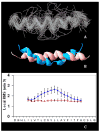Mammalian diacylglycerol kinases: molecular interactions and biological functions of selected isoforms
- PMID: 19364481
- PMCID: PMC2744455
- DOI: 10.1016/j.bbagen.2009.01.010
Mammalian diacylglycerol kinases: molecular interactions and biological functions of selected isoforms
Abstract
The mammalian diacylglycerol kinases (DGK) are a group of enzymes having important roles in regulating many biological processes. Both the product and the substrate of these enzymes, i.e. diacylglycerol and phosphatidic acid, are important lipid signalling molecules. Each DGK isoform appears to have a distinct biological function as a consequence of its location in the cell and/or the proteins with which it associates. This review discusses three of the more extensively studied forms of this enzyme, DGKalpha, DGKvarepsilon, and DGKzeta. DGKalpha has an important role in immune function and its activity is modulated by several mechanisms. DGKvarepsilon has several unique features among which is its specificity for arachionoyl-containing substrates, suggesting its importance in phosphatidylinositol cycling. DGKzeta is expressed in many tissues and also has several mechanisms to regulate its functions. It is localized in several subcellular organelles, including the nucleus. The current state of our understanding of the properties and functions of these proteins is reviewed.
Figures




Similar articles
-
The alpha isoform of diacylglycerol kinase exhibits arachidonoyl specificity with alkylacylglycerol.Biochemistry. 2004 Nov 23;43(46):14778-83. doi: 10.1021/bi0484724. Biochemistry. 2004. PMID: 15544348
-
Lipid modulation of the activity of diacylglycerol kinase alpha- and zeta-isoforms: activation by phosphatidylethanolamine and cholesterol.Biochemistry. 2004 Nov 23;43(46):14767-77. doi: 10.1021/bi049145z. Biochemistry. 2004. PMID: 15544347
-
Properties and functions of diacylglycerol kinases.Cell Signal. 2000 Oct;12(9-10):595-605. doi: 10.1016/s0898-6568(00)00113-3. Cell Signal. 2000. PMID: 11080611 Review.
-
Protein kinase C inhibits binding of diacylglycerol kinase-zeta to the retinoblastoma protein.Biochim Biophys Acta. 2007 Mar;1773(3):352-7. doi: 10.1016/j.bbamcr.2006.12.004. Epub 2006 Dec 13. Biochim Biophys Acta. 2007. PMID: 17239975
-
Where do substrates of diacylglycerol kinases come from? Diacylglycerol kinases utilize diacylglycerol species supplied from phosphatidylinositol turnover-independent pathways.Adv Biol Regul. 2018 Jan;67:101-108. doi: 10.1016/j.jbior.2017.09.003. Epub 2017 Sep 9. Adv Biol Regul. 2018. PMID: 28918129 Review.
Cited by
-
Diacylglycerol kinase η colocalizes and interacts with apoptosis signal-regulating kinase 3 in response to osmotic shock.Biochem Biophys Rep. 2021 Apr 27;26:101006. doi: 10.1016/j.bbrep.2021.101006. eCollection 2021 Jul. Biochem Biophys Rep. 2021. PMID: 33997319 Free PMC article.
-
Altered expression of diacylglycerol kinase isozymes in regenerating liver.J Histochem Cytochem. 2012 Feb;60(2):130-8. doi: 10.1369/0022155411429154. Epub 2011 Dec 28. J Histochem Cytochem. 2012. PMID: 22205637 Free PMC article.
-
Influence of DGKH variants on amygdala volume in patients with bipolar affective disorder and schizophrenia.Eur Arch Psychiatry Clin Neurosci. 2015 Mar;265(2):127-36. doi: 10.1007/s00406-014-0513-9. Epub 2014 Jun 24. Eur Arch Psychiatry Clin Neurosci. 2015. PMID: 24958494
-
Subcellular Localization Relevance and Cancer-Associated Mechanisms of Diacylglycerol Kinases.Int J Mol Sci. 2020 Jul 26;21(15):5297. doi: 10.3390/ijms21155297. Int J Mol Sci. 2020. PMID: 32722576 Free PMC article. Review.
-
DGKα in Neutrophil Biology and Its Implications for Respiratory Diseases.Int J Mol Sci. 2019 Nov 13;20(22):5673. doi: 10.3390/ijms20225673. Int J Mol Sci. 2019. PMID: 31766109 Free PMC article. Review.
References
-
- Rhee SG, Bae YS. Regulation of phosphoinositide-specific phospholipase C isozymes. J Biol Chem. 1997;272:15045–15048. - PubMed
-
- Newton AC. Regulation of protein kinase C. Cell Biology. 1997;9:161–167. - PubMed
-
- Toker A. Signaling through protein kinase C. Frontiers in Bioscience. 1998;3:d1134–1147. - PubMed
-
- Ebinu JO, Bottorff DA, Chan EYW, Stang SL, Dunn RJ, Stone JC. RasGRP, a ras guanyl nucleotide-releasing protein with calcium-and diacylglycerol-binding motifs. Science. 1998;280:1082–1086. - PubMed
Publication types
MeSH terms
Substances
Grants and funding
LinkOut - more resources
Full Text Sources

